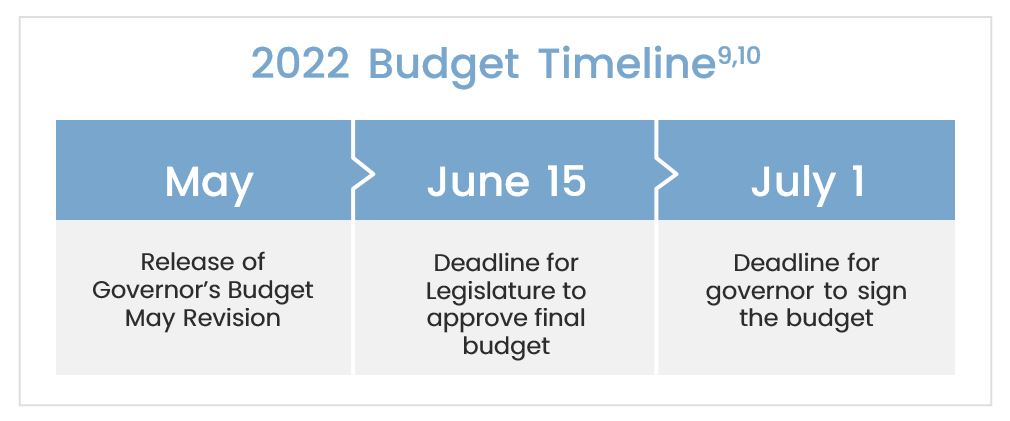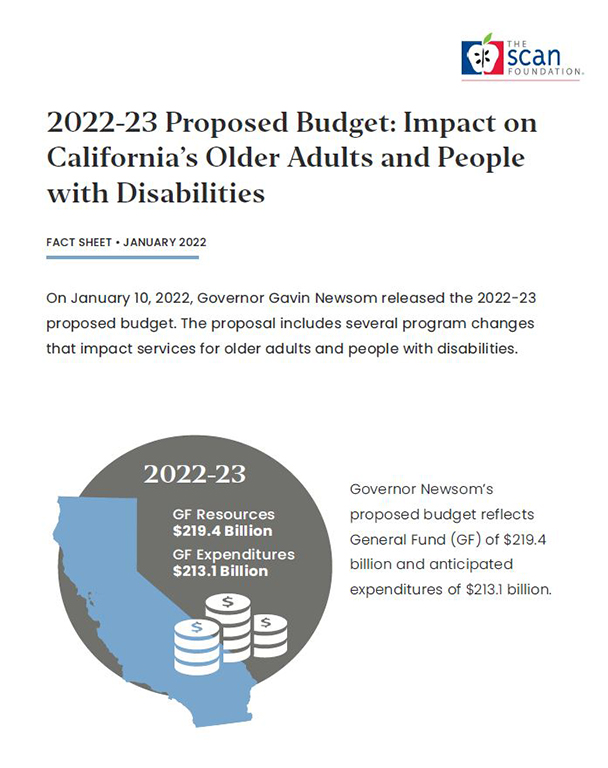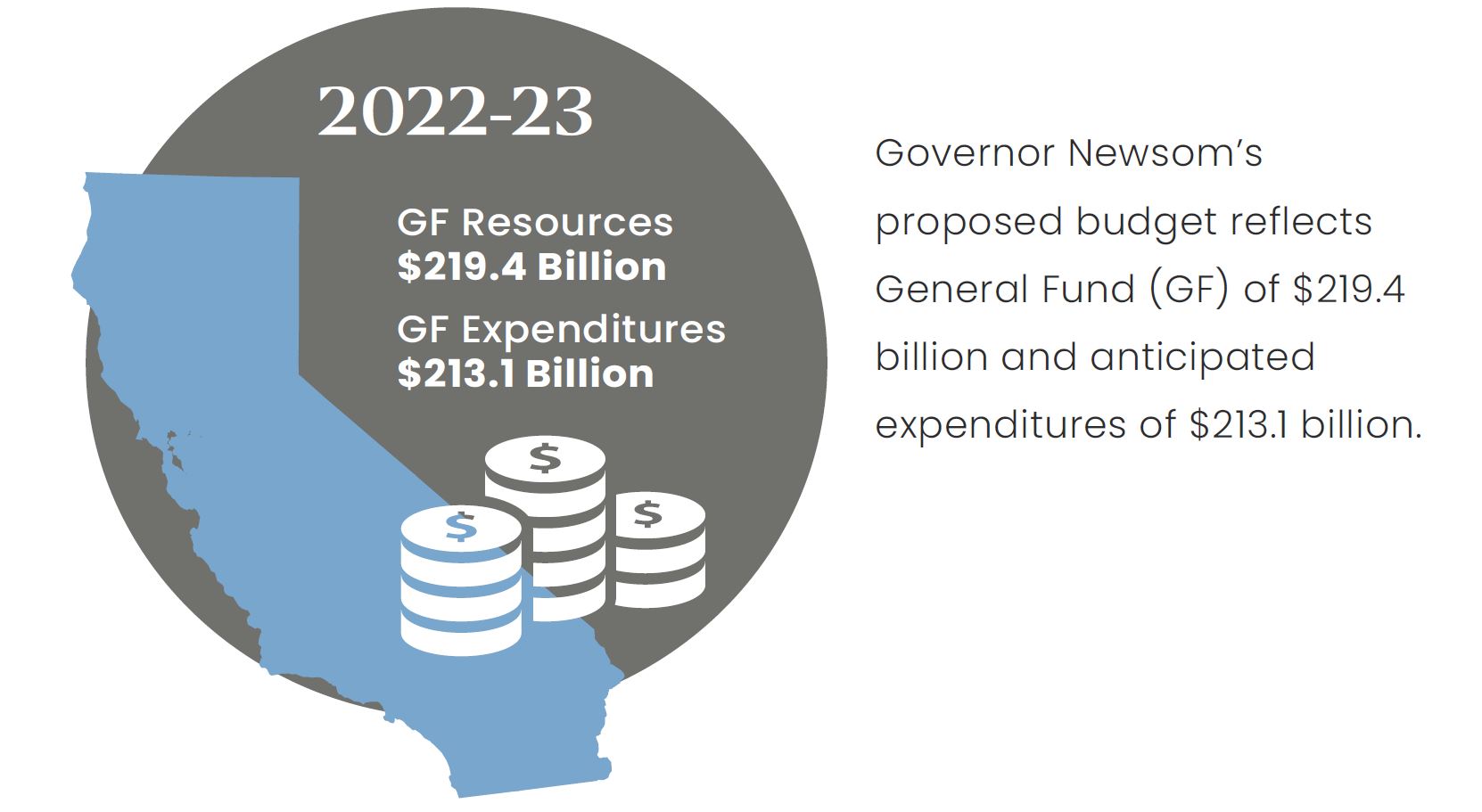2022-23 Proposed Budget: Impact on California’s Older Adults and People with Disabilities
summary
On January 10, 2022, Governor Gavin Newsom released the 2022-23 proposed budget. The proposal includes several program changes that impact services for older adults and people with disabilities.
Date Updated: 01/26/2022Overview
On January 10, 2022, Governor Gavin Newsom released the 2022-23 proposed budget, outlining the state’s projected revenues and spending plan for the fiscal year beginning on July 1, 2022, and ending June 30, 2023. The proposed budget includes total General Fund (GF) resources of $219.4 billion and anticipated expenditures of $213.1 billion, with the rest held in reserve. The proposed budget reflects a Budget Stabilization Account* balance of $20.9 billion, and a Safety Net Reserve† balance of $900 million. The Rainy Day Fund is at its constitutional maximum (10 percent of GF revenues), requiring $2.4 billion to be directed toward infrastructure investments.1, 2
Governor Newsom’s 2022-23 proposed budget outlines his top priorities for the year ahead—including addressing climate change, workforce issues, health care access, affordable housing, economic security, and other initiatives that impact older adults and people with disabilities.2
Background: Master Plan for Aging, Community-Based Care, and CalAIM
January 2022 marked the one-year anniversary of California’s Master Plan for Aging (Master Plan), a 10-year blueprint to address the needs of aging Californians and system challenges across housing, transportation, health care, long-term services and supports, and others. The enacted 2021-22 budget contained significant investments for Master Plan implementation. This included the enhanced funding for California’s Home- and Community-Based Services (HCBS) Spending Plan, made available through the American Rescue Plan Act of 2021. California received approval for the $4.6 billion HCBS Spending Plan from the Centers for Medicare and Medicaid Services (CMS) on January 4, 2022.3,4 The state also received CMS approval for the 1115 and 1915(b) waivers authorizing implementation of California Advancing and Innovating Medi-Cal (CalAIM) beginning January 1, 2022.5 The proposed 2022-23 budget builds off these key investments and regulatory approvals to include additional funding for specified Master Plan priorities.2
Budget Items Impacting Older Adults, People with Disabilities, and Their Caregivers
The governor’s 2022-23 proposed budget includes the following proposals that impact older adults, people with disabilities, and their caregivers—several of which connect with Master Plan priorities.
Table 1 highlights items that directly support Master Plan implementation.
| Table 1: Master Plan for Aging2 | ||
| Item | Proposed Budget Action | Estimated Investment |
| Data Dashboard | Bolsters the Master Plan Data Dashboard to drive outcomes $2.1 million and sustain public engagement | $1.7 billion GF‡ (over three years) |
Table 2 includes care economy workforce initiatives, as well as proposals for employment equity and volunteerism for older adults and people with disabilities.
| Table 2: Workforce and Volunteer Infrastructure2,6 | ||
| Item | Proposed Budget Action | Estimated Investment |
| Care Economy Workforce | Creates opportunities to expand, support, and diversify the health and human services workforce | $1.7 billion GF‡ (over three years) |
| California Leads as an Employer | Builds an equitable state workforce that reflects California’s diversity, including age and disability | $7.6 million ($6.3 million GF) |
| Older Adult Volunteer Opportunities | Engages older adults in intergenerational and peer-to-peer volunteer opportunities | $10 million GF‡ |
Table 3 includes health care investments that expand access to Medi-Cal and implement CalAIM.
| Table 3: Health Care and Long-Term Care2,7,8 | ||
| Item | Proposed Budget Action | Estimated Investment |
| Alzheimer’s Healthy Brain Initiative | Continues support for existing grantees in six local health jurisdictions with expansion to up to six more | $10 million GF‡ |
| CalAIM | Implements the following initiatives:
|
$2.8 billion ($982.6 million GF) |
| Cognitive Health Assessments | Implements cognitive health assessments for Medi-Cal beneficiaries age 65 and older | $341,000 ($171,000 GF) |
| Home and Community-Based Alternatives (HCBA) Waiver | Funds provisions of a recently submitted HCBA waiver renewal, including increase in available slots, expansion of Community Transition Services, and assistive technology, among others | $304 million ($152 million GF) |
| In-Home Supportive Services Back-Up Provider System | Establishes a permanent back-up provider system | $24.8 million ($11.2 million GF) |
| Medi-Cal Asset Limit | Phases in elimination of the Medi-Cal asset limit with full elimination no sooner than January 1, 2024 | $200.7 million ($93.4 million GF) |
| Medi-Cal Expansion | By January 2024, expands Medi-Cal to eligible adults ages 26-49 regardless of immigration status, providing coverage for immigrants with disabilities (builds on expansion to adults age 50 and older effective May) | $819.4 million ($613.5 million GF) |
| Medi-Cal Premiums | Reduces Medi-Cal premiums for working adults with disabilities | $1.5 million GF |
| Nursing Facility Financing | Changes funding from primarily cost-based to value-based | $46 million GF |
Table 4 highlights future investments related to economic security and addresses elder justice.
| Table 4: Economic and Housing Security, and Elder Justice2,7 | ||
| Item | Proposed Budget Action | Estimated Investment |
| California Food Assistance Program | Expands the California Food Assistance Program in 2025-26 for adults age 55 and older, regardless of immigration status | $35.2 million GF (for planning)$113.4 million GF (2025-26) |
| State Supplementary Payment (SSP) | Assumes a 24 percent increase in the SSP on January 1, 2024 | $296 million GF (2023-24) |
| Affordable Housing | Invests in initiatives to accelerate development of affordable housing | $9 billion |
| Homelessness | Invests in initiatives to address homelessness, including behavioral health housing and encampment cleanup grants as a bridge to efforts such as HomeKey and CalAIM | $8 billion |
| Returning Home Well Program | Provides transitional housing to parolees (of whom 25 percent are age 50 or older) | $10.6 million GF (over three years) |
| State Liaison to County Probate Conservators | Funds a new position to coordinate with county Public Conservator agencies serving people with probate conservatorships | No amount listed |
Next Steps in the Budget Process
California’s 2022-23 Governor’s Budget requires approval by the Senate and the Assembly prior to being sent to the governor for his signature. Below is a list of key budget dates:

Download the publication for all visuals and complete references.
Continue Reading
This policy brief provides an introduction to The SCAN Foundation’s CLASS Technical Assistance Brief Series, which explores many of the critical issues to be considered for successfully implementing CLASS.
This policy brief describes the broad needs of individuals with disability and the wide range of supportive and environmental solutions that can allow for the most independent living possible. It suggests how findings on social and environmental supports for individuals with disability can inform implementation of CLASS.
This policy brief provides background on the historical development of benefit eligibility triggers in the private long-term care insurance market. Understanding how these triggers came into being can provide important information to those charged with implementing the CLASS Plan.



